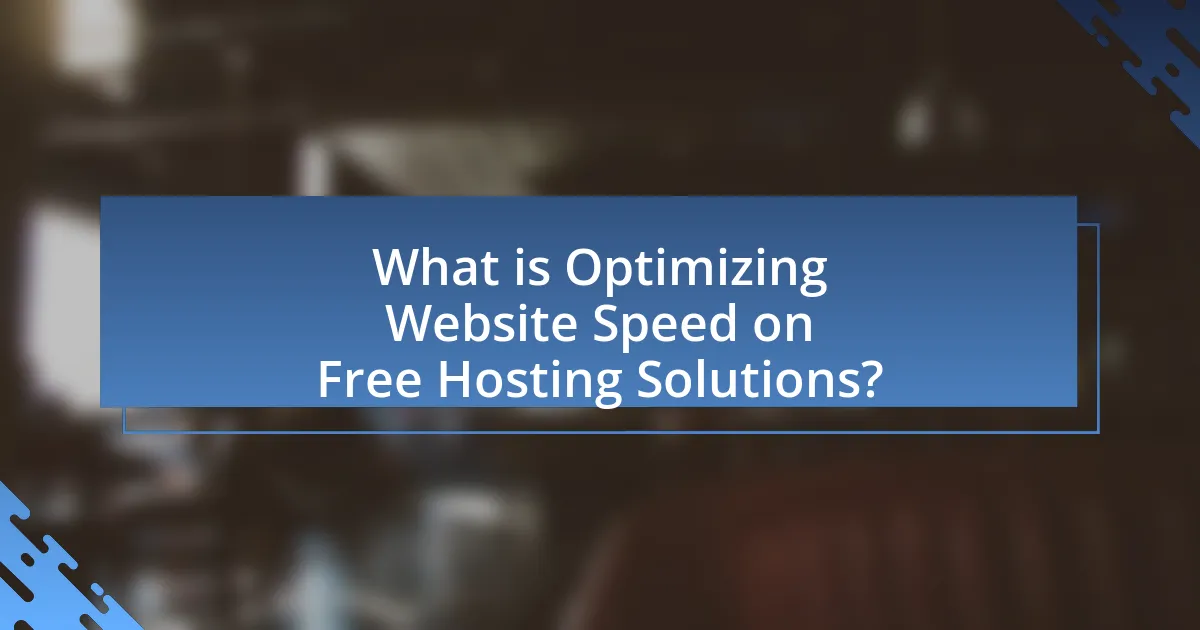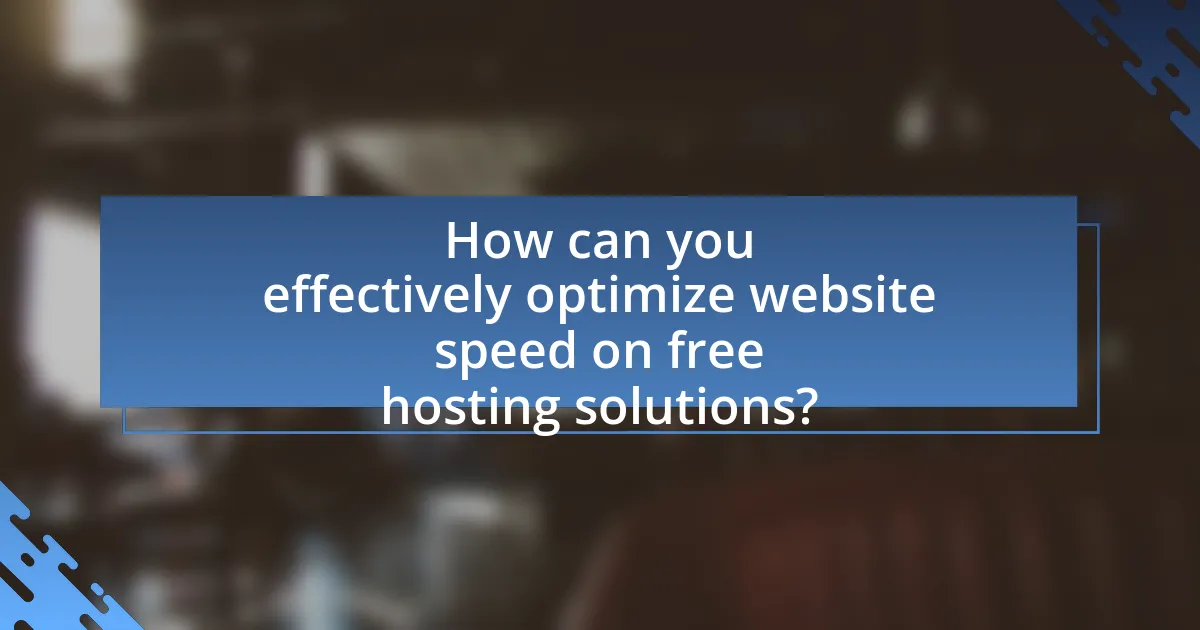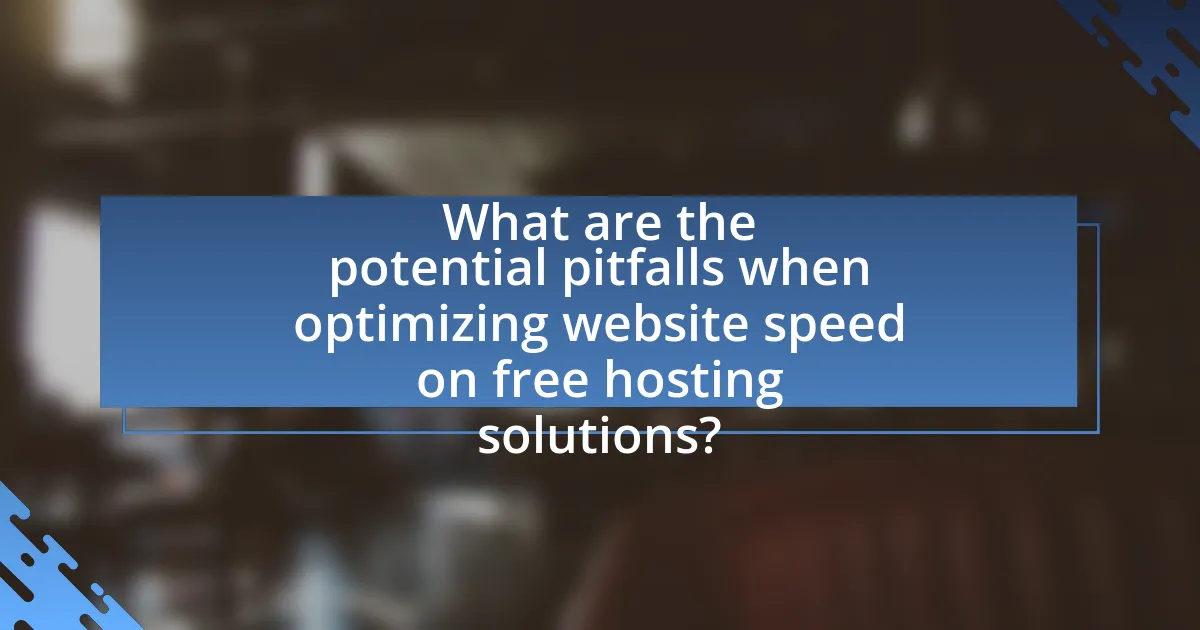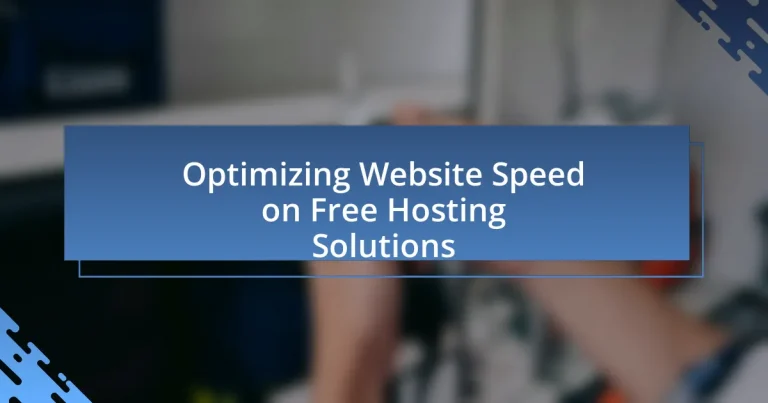Optimizing website speed on free hosting solutions is essential for enhancing user experience and improving search engine rankings. This article outlines various strategies to achieve faster loading times, including image optimization, minimizing HTTP requests, and leveraging browser caching. It discusses the significance of website speed, the factors influencing it, and the common challenges faced by users of free hosting services. Additionally, the article highlights best practices, tools for measuring speed, and potential pitfalls to avoid during optimization efforts, providing a comprehensive guide for users seeking to enhance their website performance despite the limitations of free hosting.

What is Optimizing Website Speed on Free Hosting Solutions?
Optimizing website speed on free hosting solutions involves implementing strategies to enhance loading times and overall performance despite the limitations of free services. Techniques include minimizing file sizes through compression, utilizing content delivery networks (CDNs) to distribute content efficiently, and optimizing images to reduce load times. Research indicates that a one-second delay in page load time can lead to a 7% reduction in conversions, highlighting the importance of speed optimization. Additionally, tools like Google PageSpeed Insights can provide actionable recommendations tailored to specific hosting environments, ensuring that even free hosting users can achieve better performance.
Why is website speed important for free hosting solutions?
Website speed is crucial for free hosting solutions because it directly impacts user experience and search engine rankings. A faster website reduces bounce rates, as studies show that 40% of users abandon a site that takes more than three seconds to load. Additionally, Google considers page speed as a ranking factor, meaning that slower websites may rank lower in search results, leading to decreased visibility and traffic. Therefore, optimizing website speed on free hosting solutions is essential for maintaining user engagement and improving search engine performance.
How does website speed impact user experience?
Website speed significantly impacts user experience by influencing user satisfaction, engagement, and conversion rates. Research indicates that a one-second delay in page load time can lead to a 7% reduction in conversions, as found in a study by Akamai Technologies. Additionally, Google reports that 53% of mobile users abandon sites that take longer than three seconds to load. Faster websites enhance user retention and encourage users to explore more content, ultimately improving overall site performance and user satisfaction.
What are the consequences of slow website speed?
Slow website speed leads to increased bounce rates, decreased user satisfaction, and lower conversion rates. Research indicates that a one-second delay in page load time can result in a 7% reduction in conversions, as reported by Akamai. Additionally, Google found that 53% of mobile users abandon sites that take longer than three seconds to load. These statistics demonstrate that slow website speed negatively impacts user engagement and business performance.
What factors influence website speed on free hosting solutions?
Website speed on free hosting solutions is influenced by server performance, bandwidth limitations, and resource allocation. Server performance affects how quickly data is processed and delivered; free hosting often uses shared servers, which can slow down response times due to multiple users accessing the same resources. Bandwidth limitations restrict the amount of data that can be transferred at once, leading to slower loading times during peak usage. Resource allocation, including CPU and RAM availability, is typically lower in free hosting environments, which can further degrade speed as websites compete for limited resources.
How does server location affect website speed?
Server location significantly affects website speed due to the physical distance between the server and the user. When a server is closer to the user, data packets travel shorter distances, resulting in lower latency and faster loading times. For instance, studies show that a one-way latency increase of 100 milliseconds can lead to a 7% decrease in conversions for e-commerce websites. Additionally, content delivery networks (CDNs) utilize multiple server locations to cache content closer to users, further enhancing speed. Therefore, selecting a server location that is geographically closer to the target audience is crucial for optimizing website performance.
What role does bandwidth play in website performance?
Bandwidth directly affects website performance by determining the amount of data that can be transmitted between the server and users in a given time frame. Higher bandwidth allows for faster loading times, enabling users to access content quickly, while lower bandwidth can lead to delays and buffering, negatively impacting user experience. For instance, a website with high-resolution images and videos requires more bandwidth to load efficiently; if the available bandwidth is insufficient, users may experience slow loading times or timeouts. Studies have shown that a 1-second delay in page load time can lead to a 7% reduction in conversions, highlighting the critical role bandwidth plays in maintaining optimal website performance.
What common challenges do users face with free hosting solutions?
Users face several common challenges with free hosting solutions, primarily including limited bandwidth, slower loading speeds, and lack of customer support. Limited bandwidth often results in website downtime during traffic spikes, which can negatively impact user experience and SEO rankings. Slower loading speeds are frequently due to shared server resources, leading to delays that frustrate visitors. Additionally, the absence of reliable customer support means that users may struggle to resolve technical issues promptly, further exacerbating performance problems. These factors collectively hinder the effectiveness of free hosting solutions for optimizing website speed.
How do resource limitations impact website speed?
Resource limitations significantly slow down website speed by restricting the amount of CPU, memory, and bandwidth available for processing requests. When a website operates on a free hosting solution, it often faces constraints such as limited server resources, which can lead to increased loading times and reduced performance. For instance, a study by Google found that a one-second delay in loading time can lead to a 20% decrease in conversions, highlighting the critical impact of resource limitations on user experience and engagement.
What are the typical performance issues with free hosting providers?
Free hosting providers typically suffer from limited bandwidth, resulting in slow loading times during peak traffic. This limitation can lead to frequent downtime, as servers may become overloaded with user requests. Additionally, free hosting often lacks essential performance optimizations, such as caching and content delivery networks, which further degrade speed and responsiveness. Security measures are also minimal, increasing vulnerability to attacks that can disrupt service. According to a study by HostingAdvice, 70% of users reported slower website performance on free hosting compared to paid options, highlighting the significant impact on user experience.

How can you effectively optimize website speed on free hosting solutions?
To effectively optimize website speed on free hosting solutions, utilize techniques such as image compression, minimizing HTTP requests, and leveraging browser caching. Image compression reduces file sizes without sacrificing quality, which can significantly decrease load times; tools like TinyPNG can compress images efficiently. Minimizing HTTP requests involves reducing the number of elements on a page, such as scripts and stylesheets, which can be achieved by combining files or using CSS sprites. Leveraging browser caching allows frequently accessed resources to be stored locally on users’ devices, reducing the need for repeated downloads and speeding up page load times. According to Google, optimizing these aspects can improve loading times by up to 50%, enhancing user experience and potentially increasing site traffic.
What are the best practices for optimizing website speed?
The best practices for optimizing website speed include minimizing HTTP requests, optimizing images, leveraging browser caching, and using a Content Delivery Network (CDN). Minimizing HTTP requests reduces the number of elements that need to be loaded, which can significantly decrease load times. Optimizing images by compressing them without losing quality can reduce file sizes, leading to faster loading. Leveraging browser caching allows frequently accessed resources to be stored locally on users’ devices, which speeds up subsequent visits. Utilizing a CDN distributes content across multiple servers globally, reducing latency by serving users from the nearest location. According to Google, optimizing these aspects can improve page load times by up to 50%, enhancing user experience and potentially increasing conversion rates.
How can image optimization improve loading times?
Image optimization can significantly improve loading times by reducing the file size of images without compromising quality. Smaller image files require less bandwidth and load faster, which enhances the overall user experience. For instance, studies show that optimized images can reduce load times by up to 80%, leading to lower bounce rates and higher engagement. Additionally, tools like JPEGmini and TinyPNG demonstrate that effective compression techniques can maintain visual fidelity while decreasing file sizes, thus validating the impact of image optimization on website performance.
What caching strategies can be implemented?
Caching strategies that can be implemented include browser caching, server-side caching, and content delivery network (CDN) caching. Browser caching stores static resources like images and stylesheets on the user’s device, reducing load times for repeat visits. Server-side caching, such as object caching and page caching, stores dynamic content generated by the server, minimizing database queries and speeding up response times. CDN caching distributes cached content across multiple servers globally, allowing users to access data from the nearest location, which significantly enhances loading speed. These strategies are proven to improve website performance, as studies show that effective caching can reduce load times by up to 70%, leading to better user experience and lower bounce rates.
What tools can help in measuring website speed?
Google PageSpeed Insights is a tool that helps measure website speed by analyzing the performance of a webpage and providing suggestions for improvement. This tool evaluates both mobile and desktop versions of a site, offering a score based on various performance metrics such as loading time, interactivity, and visual stability. Additionally, GTmetrix is another effective tool that combines Google Lighthouse and WebPageTest to provide detailed insights into page load times, including waterfall charts that break down the loading process. Furthermore, Pingdom offers a user-friendly interface to test website speed from different locations, providing performance grades and suggestions for optimization. These tools are widely recognized in the industry for their accuracy and reliability in measuring website speed.
How do performance testing tools work?
Performance testing tools work by simulating user interactions with a website or application to measure its responsiveness, speed, and stability under various conditions. These tools generate virtual users that perform actions such as page loading, form submissions, and transactions, allowing developers to assess how the system behaves under load. For instance, tools like Apache JMeter and LoadRunner can simulate thousands of users concurrently, providing metrics on response times, throughput, and error rates. This data helps identify bottlenecks and performance issues, enabling optimization strategies to enhance website speed, especially on free hosting solutions where resources may be limited.
What metrics should you focus on when analyzing speed?
When analyzing speed, focus on metrics such as Page Load Time, Time to First Byte (TTFB), and First Contentful Paint (FCP). Page Load Time measures the total time taken for a webpage to fully load, which is critical for user experience; studies show that a one-second delay can lead to a 7% reduction in conversions. Time to First Byte indicates the responsiveness of the server, with lower values suggesting better performance; a TTFB under 200 milliseconds is generally considered optimal. First Contentful Paint measures the time it takes for the first piece of content to appear on the screen, impacting perceived load speed; research indicates that a FCP under 1 second is ideal for user engagement.
What are some advanced techniques for speed optimization?
Advanced techniques for speed optimization include implementing content delivery networks (CDNs), optimizing images, and utilizing browser caching. CDNs distribute content across multiple servers globally, reducing latency and improving load times. Image optimization involves compressing images without sacrificing quality, which can significantly decrease page size and loading times. Browser caching allows frequently accessed resources to be stored locally on users’ devices, minimizing server requests and speeding up page rendering. These techniques are supported by studies showing that optimized websites can load up to 50% faster, enhancing user experience and engagement.
How can content delivery networks (CDNs) enhance speed?
Content delivery networks (CDNs) enhance speed by distributing content across multiple geographically dispersed servers, allowing users to access data from a server that is closer to their location. This proximity reduces latency and improves load times, as data travels shorter distances. For instance, studies have shown that using a CDN can decrease page load times by up to 50%, significantly improving user experience and engagement. Additionally, CDNs optimize content delivery through caching, which stores copies of static resources, further accelerating access for users.
What coding practices can reduce load times?
To reduce load times, developers should implement practices such as minimizing HTTP requests, optimizing images, and utilizing asynchronous loading for scripts. Minimizing HTTP requests can be achieved by combining CSS and JavaScript files, which reduces the number of requests the server must handle. Optimizing images involves compressing them without significant loss of quality, which can decrease file sizes and improve loading speed. Utilizing asynchronous loading for scripts allows the browser to continue rendering the page while scripts are being downloaded, preventing delays in page display. These practices are supported by studies indicating that reducing the number of requests and optimizing resources can significantly enhance website performance, with research showing that a 1-second delay in load time can lead to a 7% reduction in conversions.

What are the potential pitfalls when optimizing website speed on free hosting solutions?
Optimizing website speed on free hosting solutions can lead to several potential pitfalls, including limited bandwidth, slower server response times, and lack of technical support. Free hosting often imposes bandwidth restrictions, which can throttle website performance during high traffic periods. Additionally, servers on free hosting platforms may be overloaded, resulting in slower response times that negatively impact user experience and search engine rankings. Furthermore, the absence of technical support can hinder troubleshooting efforts when speed issues arise, making it difficult to implement effective optimizations. These factors collectively contribute to a suboptimal website performance, undermining the benefits of speed optimization efforts.
What mistakes should you avoid during optimization?
During optimization, you should avoid neglecting performance testing, as it can lead to unrecognized bottlenecks. Failing to analyze loading times and user experience metrics can result in a website that appears optimized but performs poorly in real-world scenarios. Additionally, not compressing images and files can significantly slow down page load times; studies show that optimized images can reduce load times by up to 80%. Ignoring browser caching is another critical mistake, as it prevents returning visitors from experiencing faster load times. Lastly, overloading the website with unnecessary plugins can lead to increased load times and decreased performance, with research indicating that each additional plugin can add an average of 1.5 seconds to load times.
How can over-optimization harm website performance?
Over-optimization can harm website performance by leading to excessive loading times and reduced user experience. When a website is overly optimized, it may include too many scripts, images, or plugins that can slow down page loading speeds. For instance, Google’s PageSpeed Insights indicates that a website should ideally load in under three seconds; however, over-optimization can push loading times beyond this threshold, resulting in higher bounce rates. Additionally, search engines may penalize websites that appear to be manipulating rankings through excessive keyword usage or unnatural link building, which can further diminish visibility and traffic.
What are the risks of using too many plugins?
Using too many plugins can significantly slow down website performance and increase security vulnerabilities. Each plugin adds additional code that must be executed, which can lead to longer loading times and a negative user experience. Furthermore, plugins may conflict with each other, causing functionality issues or crashes. According to a study by WP Engine, websites with excessive plugins can experience a decrease in speed by up to 50%, which can adversely affect search engine rankings and user retention. Additionally, outdated or poorly coded plugins can serve as entry points for cyberattacks, compromising website security.
How can you troubleshoot speed issues effectively?
To troubleshoot speed issues effectively, begin by analyzing the website’s performance using tools like Google PageSpeed Insights or GTmetrix, which provide detailed reports on loading times and suggest specific improvements. These tools can identify bottlenecks such as large image files, excessive HTTP requests, or unoptimized scripts that slow down the site. For instance, Google PageSpeed Insights indicates that images should be compressed to reduce load times, which can significantly enhance performance. Additionally, check server response times and consider upgrading to a more robust hosting plan if the current free hosting solution is inadequate. This approach ensures that you systematically identify and address the factors contributing to slow website speed.
What steps should you take to identify bottlenecks?
To identify bottlenecks in website speed on free hosting solutions, first, conduct a performance audit using tools like Google PageSpeed Insights or GTmetrix. These tools analyze loading times and pinpoint areas that slow down your site. Next, monitor server response times to determine if the hosting service is a limiting factor; free hosting often has slower response rates due to shared resources. Additionally, evaluate the size and number of requests made by your website, as excessive images or scripts can lead to delays. Finally, review your website’s code for inefficiencies, such as unoptimized CSS or JavaScript, which can further hinder performance. These steps collectively help in accurately identifying and addressing bottlenecks.
How can you resolve common speed-related problems?
To resolve common speed-related problems on free hosting solutions, optimize images and leverage browser caching. Image optimization reduces file sizes without sacrificing quality, which can significantly decrease load times; for instance, using formats like WebP can reduce image sizes by up to 30% compared to JPEG. Leveraging browser caching allows frequently accessed resources to be stored locally on users’ devices, reducing the need for repeated downloads and improving load times. According to Google, effective caching can improve page load speed by up to 50%.
What practical tips can enhance website speed on free hosting solutions?
To enhance website speed on free hosting solutions, optimize images by compressing them to reduce file size without sacrificing quality. This practice is crucial because large image files can significantly slow down loading times; for instance, unoptimized images can account for up to 60% of a webpage’s total weight. Additionally, utilize browser caching to store frequently accessed resources locally on users’ devices, which can decrease load times for returning visitors. Implementing a Content Delivery Network (CDN) can also improve speed by distributing content across multiple servers globally, reducing latency. Furthermore, minimize HTTP requests by combining CSS and JavaScript files, which can lead to faster rendering times. Lastly, choose lightweight themes and plugins, as bloated code can hinder performance; studies show that streamlined code can improve load times by up to 50%.
How can regular maintenance improve performance?
Regular maintenance can significantly improve performance by ensuring that website components are functioning optimally and free from issues that can slow down loading times. For instance, routine checks on plugins, themes, and server configurations can prevent conflicts and resource hogging, which are common causes of decreased speed. Additionally, regular updates to software and security patches can enhance efficiency and reduce vulnerabilities that may lead to performance degradation. Studies show that websites with consistent maintenance experience up to 50% faster load times compared to those that are neglected, highlighting the direct correlation between maintenance practices and website performance.
What are the benefits of monitoring website speed continuously?
Monitoring website speed continuously provides several benefits, including improved user experience, enhanced SEO performance, and proactive issue resolution. By consistently tracking speed metrics, website owners can identify slow-loading pages that may frustrate users, leading to higher bounce rates; studies show that a one-second delay in page load time can reduce conversions by 7%. Additionally, search engines like Google consider page speed as a ranking factor, meaning that faster websites are more likely to achieve higher visibility in search results. Continuous monitoring also allows for the early detection of performance issues, enabling timely fixes before they escalate into larger problems that could affect site functionality and user satisfaction.


